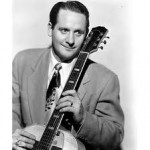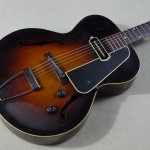History
 For those of you who have an interest in the history of the instrument … I have created this section. Needless to say, there won't be any video lesson but I will include some great links to help you journey into the past!
For those of you who have an interest in the history of the instrument … I have created this section. Needless to say, there won't be any video lesson but I will include some great links to help you journey into the past!
 History and Development of the Guitar
History and Development of the Guitar
Guitarists know a lot about their musical instruments–techniques, chords, songs etc. But what many guitarists don't know is the history of the guitar. It's understandable, because many people don't feel this helps at all in actually playing the guitar. Still, it is helpful to know everything about the instrument–including the history.
The history of guitar is a debatable topic, as there are no concrete facts about the guitar and when exactly it first appeared. What is known, though, is that guitars or similar instruments have been around for over 5,000 years. Entire books could be written about the history of guitar, so in this article, we'll just go over a timeline of how it is thought the guitar evolved.
1400 B.C: The Hittites play a four-string, guitar-like instrument. This four string instrument had soft, curved sides, which were somewhat similar to the current guitar. Also around this time, the Greeks produced a similar instrument which was modified by the Romans and became known as the cithara.
By 1200 A.D.: There were two types of guitars. One type was known as the Moorish guitar (guitarra morisca). This guitar had a wide fingerboard, rounded back, and several sound holes. The type of guitar was the Latin guitar (guitarra Latina). The Latin guitar looked more like our current guitar with a narrower neck and just one sound hole.
The late 1400's: A new guitar, called the vihuela, evolved from the two types of guitar mentioned. The vihuela was a large instrument with double the strings of the Latin and Moorish guitars, a longer neck and ten or eleven frets. The Portuguese and Spanish courts preferred the vihuela over any other instrument for roughly 200 years.
Until the late 1600's: The vihuela, and another instrument called the lute, were more popular than the guitar. This changed when the popularity of the lute declined because it had too many strings and was too hard to play and tune. The vihuela was replaced by four and five course guitars of that time. Four course guitars had seven strings–a single high string and three pairs of other strings–while five course guitars had nine strings–a single high string and four pairs of other strings. Some feel that the addition of the fifth course during the 16th century, which gave the guitar greater flexibility, was the reason why the guitar became popular.
By the beginning of the 1800's: Some guitars used fan struts under the soundboard and featured six strings (like the modern guitar). Also changed during this time was the neck (which was raised), the fingerboard (which used ebony or rosewood), and the tuning pegs (which were replaced with machine tuners). Guitars like these are most similar to early classical guitars.
By the late 1800s: A man named Antonio Torres Jurado changed the guitar dramatically by refining the strutting of the guitar. This allowed for as many as seven struts to be spread out like a fan under the soundboard. Additionally, the size of the body and the width of the neck were greatly increased. As a result of Jurado's improvements, the guitar had greater bass response and volume. Jurado's work made it possible for the guitar to meet the demands of both the solo performer and the concert stage.
Our modern guitar is practically the same as the one made by Jurado.
by Gray Rollins
 History of the Electric Guitar
History of the Electric Guitar
Guitars, or similar instruments, have been around for thousands of years. The Electric guitar was first manufactured in the 1930s by Rickenbacker. Original Electric guitars used tungsten pickups. Pickups basically convert the vibration of the strings into electrical current, which is then fed into the amplifier to produce the sound.
The very earliest Electric guitars featured smaller soundholes in the body. These guitars are known as semi-hollow body Electric guitars and still are somewhat popular today, mainly due to the fact that they are flexible guitars.
However, with the use of pickups, it was possible to create guitars without soundholes (like the Acoustic and Classical guitars have) that still had the ability to be heard, if plugged into amplifiers. These guitars are called solid body Electric guitars.
The Electric guitar's popularity began to increase during the Big Band era of the '30s and 40s. Due to the loudness of the brass sections in jazz orchestras, it was necessary to have guitars that could be heard above the sections. Electric guitars, with the ability to be plugged into amplifiers, filled this void.
The Electric guitar that is most prevalent today is the solid body Electric guitar. The solid body guitar was created by musician and inventor Les Paul in 1941. It is a guitar made of solid wood with no soundholes. The original solid body guitar created by Paul was very plain–it was a simple rectangular block of wood connected to a neck with six steel strings. Les Paul's original solid body guitar shape has, of course, changed from the original rectangular shape to the more rounded shape Les Paul guitars have today.
During the 1950s, Gibson introduced Les Paul's invention to the world. The Gibson Les Paul, as it was and still is called, quickly became a very popular Electric guitar. It has remained the most popular guitar for 50 years.
Around the same period of time, another inventor named Leo Fender came up with a solid body Electric guitar of his own. In the late 1940s, Fender introduced the Fender Broadcaster Electric guitar. The Broadcaster, which was renamed the Telecaster, was officially introduced to the public in 1950. It has remained a very popular model. The Stratocaster premiered in 1954. The Strat, as it is now known, was a very different guitar in comparison to the Les Paul. It had a different shape, different hardware and was significantly lighter. Fender's Stratocaster Electric guitar is the second most popular guitar in the world, second to only the Les Paul.
Over the years, other companies, such as Ibanez, Jackson, Paul Reed Smith, ESP and Yamaha have all produced solid body Electric guitars of their own. However, most Electric guitars still feature the familiar shape of a Les Paul, Tele or Strat guitar.
by Gray Rollins
{ 4 comments… read them below or add one }
Jackson, thanks for the history on the guitar, i love learning more about what i'm passionate about. thanks again,
Thanks …. we share that passion for sure!
Hi Jackson
Thanks for all your tips and stories
could you do video including base notes for Billy joel,s
the piano man best wishes Rob
Well Rob ….. I’m pretty much limited to guitar songs and my focus is on leaning chords and accompaniment for sing-along. I could probably adapt Piano Man at some point but again it would be with focus on acoustic play along. Thanks for the kind words and Merry Christmas!